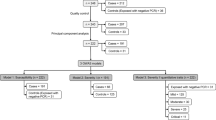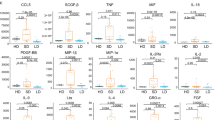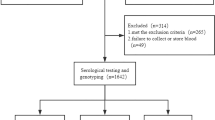Abstract
Interferon lambda 4 (IFNλ4) has shown antiviral activity against RNA viruses, including some coronaviruses. Besides, genetic variants of IFNL4 can be predictive of the clearance of RNA viruses. However, little is known about the effect of these genetic variants on SARS-CoV-2 infection. In this study, we investigated whether there was a relationship of the rs12979860 polymorphism of IFNL4 with COVID-19. We found that the T allele of rs12979860 was overexpressed in COVID-19 patients with regard to the general population without this disease (36.16% vs. 26.40%, p = 6.4 × 10–4; OR 0.633 C vs T; 95% CI 0.487, 0.824), suggesting that this allele could be a risk factor for COVID-19. Accordingly, the CC genotype was significantly lower in COVID-19 patients compared to controls (37.85% vs. 55.51%, p = 8 × 10–5; OR 0.488; 95% CI 0.342, 0.698). These results were not affected by sex, age, and disease severity in patients with COVID-19. Our findings suggest that, like other infectious diseases caused by RNA viruses, genetic variants of IFNL4 can predispose to COVID-19. Confirmation of our results may contribute to better understanding the mechanisms of this disease.
Similar content being viewed by others
Introduction
Coronavirus disease-19 (COVID-19) is characterized by a set of symptoms that develop following infection with severe acute respiratory syndrome coronavirus 2 (SARS-CoV-2)1. Besides viral genetic variations, it is accepted that social, economic, and host factors can affect the incidence of COVID-192. Thus, the characterization of the host genetic factors contributing to this disease would be of great interest for prognosis and treatment.
Interferons (IFNs) are believed to play an important role in the outcome of COVID-19. Reports have shown that type I IFN deficiencies can lead to severe disease3. However, trials investigating the efficacy of type I IFN treatments have shown inconsistent results4,5. Growing evidence suggests that type III IFNs may also play a role in host defense against SARS-CoV-26. Among them, little is known about the role of interferon lambda 4 (IFNλ4), even though it has shown antiviral activity against RNA viruses, including some coronaviruses7. The importance of this cytokine in viral infections was highlighted by the discovery that genetic variants of IFNL4 could be predictive of viral clearance. Thus, the rs12979860 single nucleotide polymorphism has been associated with the clearance of hepatitis C virus (HCV) and RNA viruses of the upper respiratory tract8,9,10. Furthermore, this polymorphism is also associated with response to type I IFN treatments in chronic hepatitis C11. With these antecedents, we investigated whether there was also a relationship of IFNL4 genetic variants with COVID-19. To this end, we analyzed the rs12979860 polymorphism in IFNL4 in a cohort of COVID-19 patients and compared it with the general population without this disease.
Results
The characteristics of 177 COVID-19 patients and 445 non-COVID-19 controls by gender and age are shown in Table 1. The proportion of female and male between COVID-19 patients and controls was similar (p = 0.673; OR 1.078; 95% CI (0.760; 1.528). The average age was 68 (± 16) years old in the COVID-19 group and 49 (± 29) years old in the control group. However, the percentage of age ≥ 65 years was higher in COVID-19 patients (58.76% vs 43.60%, p = 0.01; OR 0.543; 95% CI 0.381, 0.772). Patients were subdivided into non-severe- (n = 132, 74.58%) and severe-COVID-19 (n = 45, 25.42%).
The genotype and allele frequencies of the rs12979680 polymorphism are shown in Table 2. The T allele was overexpressed in the COVID-19 patients with regard to controls (36.16% vs. 26.40%, p = 6.4 × 10–4; OR 0.633 C vs T; 95% CI (0.487, 0.824), suggesting that this allele could be a risk factor to develop COVID-19. Accordingly, the CC genotype was significantly lower in COVID-19 patients compared to controls (37.85% vs. 55.51%, p = 8 × 10–5; OR 0.488; 95% CI (0.342, 0.698). Then, we analyzed whether the ratio of rs12979860 genotypes was affected by sex, age, and severity of disease in the COVID-19 group, comparing the protective CC genotype versus CT + TT (Table 3). Using Chi-square test, we found no significant differences between female and male (p = 0.155; OR 0.642; 95% CI (0.349, 1.184), younger and older than 65-year-old (p = 0.618; OR 1.145; 95% CI (0.618, 2.119), and severe and non-severe disease (p = 0.484; OR 1.279; 95% CI (0.642, 2.549).
Discussion
This is a study comparing a genetic variant of IFNL4 in a population of COVID-19 patients with the general population without this disease. Genetic variants of IFNL4 have already been associated with viral clearance of HCV and other RNA viruses8,9,10,11. In this study, we have found that the rs12979860 polymorphism in IFNL4 was also associated with the presence of symptomatic SARS-CoV-2 infection. Thus, the T allele of rs12979860 was significantly overexpressed in COVID-19 patients regarding non-COVID-19 controls, suggesting that this allele may be a risk factor for COVID-19. Accordingly, the frequency of the CC genotype was lower in the COVID-19 group. Our study did not provide evidence to explain this observation; however, the T allele has already been associated with ineffective viral clearance of HCV and other RNA viruses8,9,10,11. In contrast, the CC genotype favors clearance of these viruses8,10. The rs12979680 polymorphism is in strong linkage disequilibrium with the rs368234815 polymorphism of IFNL4 that determines the production of IFNλ49. Thus, the T allele of rs12979860 is linked to the production of IFNλ4 while the C allele to the inactivation of the IFNL4 gene. Intriguingly, the production of IFNλ4 does not facilitate the clearance of RNA viruses, and patients carrying the T allele are less likely to resolve spontaneous HCV clearance9. It is tempting to hypothesize that the lack of IFNλ4 production may also favor spontaneous clearance of SARS-CoV-2. In this regard, the frequency of the CC genotype was similar between the COVID-19 patients and a cohort of 309 patients with chronic hepatitis C in our hospital (37.85% vs. 34.60%, data not shown), suggesting a similar effect of IFNL4 polymorphisms in these diseases. However, it would be necessary to carry out further experiments such as analyzing these polymorphisms in asymptomatic individuals to confirm this hypothesis.
We propose that confirming our findings can help to understand some facts about COVID-19 that may be influenced by IFNL4 polymorphisms. In this regard, social and economic factors have been proposed to explain the disproportionate prevalence of COVID-19 in the African-descendant population in the USA2,12. Our findings may provide an additional explanation on the basis that the T allele of rs12979860, which would be a risk factor for COVID-19 according to our results, is predominant in black populations8,10,13. Additionally, treatments with type I IFNs have shown contradictory results in COVID-194,5. It is tempting to speculate that, in addition to other factors14, IFNL4 polymorphisms may affect the response to treatments with type I IFN as in chronic hepatitis C10. Analysis of IFNL4 genetic variants may provide useful information to evaluate the efficacy of these treatments in COVID-19.
Our findings should be considered with caution, as the study has several limitations. The cohort of COVID-19 patients was not randomized, it was carried out in a single hospital, and we did not consider other potential confounding factors, such as comorbidities other than sex and age, which could influence the results. Thus, in this study we could not access to patients’ data to analyze the frequency of underlying diseases such as diabetes, obesity or cardiovascular and pulmonary diseases that have been reported as risk factors for the disease15. Therefore, our results should be interpreted as exploratory and descriptive until confirmed in further studies. However, some observations may support our findings. The allele and genotype frequencies in our control population without COVID-19 are comparable to those reported in similar populations8,12. The polymorphism was not affected by sex, age, and severity of disease in COVID-19 patients as previously reported16.
In summary, we have found that the IFNL4 rs12979860 polymorphism was associated with the presence of COVID-19 in a Spanish population. Confirmation of our results may contribute to better understanding the mechanisms of this disease.
Patients and methods
This study was conducted to analyze the IFNL4 rs12979860 single nucleotide polymorphism in a population of COVID-19 patients and compare it with a control population without this disease (non-COVID-19). This study was conducted in Caceres, a city in western Spain near the Portuguese border. Most of the population are Native Caucasians with very few foreigners (2.82%). The mean age is 44.8 years, and the life expectancy is 82.4 years (79.7 for men and 85.3 for women). (https://www.ine.es). 177 patients diagnosed with COVID-19 were consecutively recruited for genotyping analysis from April to December 2020 in the post-COVID-19 follow-up at the San Pedro de Alcantara Hospital (Caceres, Spain). The diagnosis of COVID-19 was established based on the presence of symptoms and confirmed by positive SARS-CoV-2 mRNA in respiratory secretions detected in an Applied Biosystems QuantStudio 5 qPCR by using a TaqPath COVID‑19 CE‑IVD RT‑PCR Kit (Applied Biosystems, Waltham, MA) using standard clinical laboratory procedures. All patients had positive RT-PCR for SARS-CoV-2. When indicated, patients were subdivided into non-severe- and severe-COVID-19. Severe disease was defined following the criteria of Gandhi et al. as a blood oxygen saturation < 94%; respiratory rate ≥ 30 breaths/min; pulmonary infiltration > 50%, requiring oxygen therapy15. Non-severe COVID-19 includes mild and moderate illness as described by Gandhi et al.15. Non-COVID-19 control samples were obtained from volunteer donors before 2019 to avoid interference from undetected infected donors. Patients and controls were classified by gender, age, and severity of the disease. Table 1 summarizes the population analyzed. Patients and controls gave their written informed consent and, when applicable, provided consent for banking and future analysis of biological samples. The study was approved by the San Pedro de Alcantara Hospital (Caceres, Spain) Ethical Committee for Clinical Research. The study followed all relevant guidelines and the Spanish Ministerio de Sanidad y Consumo guidelines for quality assurance in genetic testing (https://www.oecd.org/sti/emerging-tech/40931429.pdf).
Genotyping analysis. Genomic DNA was isolated from whole blood using a Nucleospin blood kit (Macherey–Nagel, Duren, Germany). Genotyping to determine rs12979860 alleles was performed in a Stratagene 3005 MxP Quantitative PCR (Agilent Technologies, Inc., Santa Clara, CA) by using a Taqman genotyping mastermix (Thermofisher Scientific, Waltham, MA) and a commercial assay also from Thermofisher Scientific (Assay ID: C___7820464_10).
Statistical analysis. Genotype and allele frequencies were obtained from sample data, comparing between patients and controls marked as COVID-19 and non-COVID-19 respectively. Categorical variables were compared using Pearson Chi-square two-sided test since the frequencies were above 5 in all cases. Normality was assumed since the size of the sample was big enough and z-tests for two proportions were adjusted for all pairwise comparisons within a row of proportions in each variable. Odds ratio (OR) and 95% confidence interval (CI) were calculated when the resulting frequency table was 2 × 2 (for the dichotomous categorical variables). P-values less than 0.05 were considered statistically significant. Comparison analyses were carried out using statistical software SPSS for Windows Release 25.0 (SPSS, Inc).
References
Vabret, N. et al. Immunology of COVID-19: Current state of the science. Immunity 52, 910–941. https://doi.org/10.1016/j.immuni.2020.05.002 (2020).
Hooper, M. W., Napoles, A. M. & Perez-Stable, J. A. COVID-19 and racial/ethnic disparities. JAMA 323, 2466–2467. https://doi.org/10.1001/jama.2020.8598 (2020).
Meffre, E. & Iwasaki, A. Interferon deficiency can lead to severe COVID. Nature 587, 374–376. https://doi.org/10.1038/d41586-020-03070-1 (2020).
Hung, I. F. et al. Triple combination of interferon beta-1b, lopinavir–ritonavir, and ribavirin in the treatment of patients admitted to hospital with COVID-19: An open-label, randomised, phase 2 trial. Lancet 395, 1695–1704. https://doi.org/10.1016/S0140-6736(20)31042-4 (2020).
WHO Solidarity Trial Consortium et al. Repurposed antiviral drugs for Covid-19. Interim WHO solidarity trial results. N. Engl. J. Med. 384, 497–511. https://doi.org/10.1056/NEJMoa2023184 (2021).
Stanifer, M. L. et al. Critical role of type III interferon in controlling SARS-CoV-2 infection in human intestinal epithelial cells. Cell Rep. 32, 107863. https://doi.org/10.1016/j.celrep.2020.107863 (2020).
Hamming, O. J. et al. Interferon lambda 4 signals via the IFNλ receptor to regulate antiviral activity against HCV and coronaviruses. EMBO J. 32, 3055–3065. https://doi.org/10.1038/emboj.2013.232 (2013).
Thomas, D. L. et al. Genetic variation in IL28B and spontaneous clearance of hepatitis C virus. Nature 461, 798–801. https://doi.org/10.1038/nature08463 (2009).
Prokunina-Olsson, L. et al. A variant upstream of IFNL3 (IL28B) creating a new interferon gene IFNL4 is associated with impaired clearance of hepatitis C virus. Nat. Genet. 45, 164–171. https://doi.org/10.1038/ng.2521 (2013).
Rugwizangoga, B. et al. IFNL4 genotypes predict clearance of RNA viruses in rwandan children with upper respiratory tract infections. Front. Cell Infect. Microbiol. 9, 340. https://doi.org/10.3389/fcimb.2019.00340 (2019).
Ge, D. et al. Genetic variation of IL28B predicts hepatitis C treatment-induced viral clearance. Nature 461, 399–401. https://doi.org/10.1038/nature08309 (2009).
Price-Haywood, E. G. et al. Hospitalization and mortality among black patients and white patients with Covid-19. N. Engl. J. Med. 382, 2534–2543. https://doi.org/10.1056/NEJMsa2011686 (2020).
Indolfi, G. et al. Comparative analysis of rs12979860 SNP of the IFNL3 gene in children with hepatitis C and ethnic matched controls using 1000 genomes project data. PLoS ONE 9, e85899. https://doi.org/10.1371/journal.pone.0085899 (2014).
Wang, N. et al. Retrospective multicenter cohort study shows early interferon therapy is associated with favorable clinical responses in COVID-19 patients. Cell Host Microbe. 28, 455-464.e2. https://doi.org/10.1016/j.chom.2020.07.005 (2020).
Gandhi, R. T., Lynch, J. B. & del Rio, C. Mild or moderate Covid-19. N. Engl. J. Med. 383, 1757–1766. https://doi.org/10.1056/NEJMcp2009249 (2020).
Amodio, E. et al. SARS-CoV-2 viral load, IFNλ polymorphisms and the course of COVID-19: An observational study. J. Clin. Med. 9, 3315. https://doi.org/10.3390/jcm9103315 (2020).
Janssens, A. C. et al. Strengthening the reporting of genetic risk prediction studies: The GRIPS statement. PLos Med. 8, e1000420. https://doi.org/10.1371/journal.pmed.1000420 (2011).
Acknowledgements
This article was designed according to the GRIPS statement guidelines17.
Funding
This work was supported in part by the Ministerio de Ciencia e Innovación (MTM2017-86875-C3-2), and Junta de Extremadura (GR18105 and GR18108). M.D.R. was supported by the Ministerio de Ciencia e Innovación (PTA2017-13904-I) and FUNDESALUD.
Author information
Authors and Affiliations
Contributions
J.M.S-C., A.C., C.M. collected the samples and supervised patients. M.D.R. performed experiments. J.M.S-C., M.D.R, F.C-A., and J.F.S. analyzed and interpreted the data. F.C-A. prepared tables. J.Z. conceived the study, designed experiments, analyzed data, and wrote the paper. All authors critically reviewed and approved the final manuscript.
Corresponding author
Ethics declarations
Competing interests
The authors declare no competing interests.
Additional information
Publisher's note
Springer Nature remains neutral with regard to jurisdictional claims in published maps and institutional affiliations.
Rights and permissions
Open Access This article is licensed under a Creative Commons Attribution 4.0 International License, which permits use, sharing, adaptation, distribution and reproduction in any medium or format, as long as you give appropriate credit to the original author(s) and the source, provide a link to the Creative Commons licence, and indicate if changes were made. The images or other third party material in this article are included in the article's Creative Commons licence, unless indicated otherwise in a credit line to the material. If material is not included in the article's Creative Commons licence and your intended use is not permitted by statutory regulation or exceeds the permitted use, you will need to obtain permission directly from the copyright holder. To view a copy of this licence, visit http://creativecommons.org/licenses/by/4.0/.
About this article
Cite this article
Saponi-Cortes, J.M.R., Rivas, M.D., Calle-Alonso, F. et al. IFNL4 genetic variant can predispose to COVID-19. Sci Rep 11, 21185 (2021). https://doi.org/10.1038/s41598-021-00747-z
Received:
Accepted:
Published:
DOI: https://doi.org/10.1038/s41598-021-00747-z
This article is cited by
-
The immunogenetics of COVID-19
Immunogenetics (2023)
-
COVID-19 GPH: tracking the contribution of genomics and precision health to the COVID-19 pandemic response
BMC Infectious Diseases (2022)
-
Interferon-λ treatment accelerates SARS-CoV-2 clearance despite age-related delays in the induction of T cell immunity
Nature Communications (2022)
Comments
By submitting a comment you agree to abide by our Terms and Community Guidelines. If you find something abusive or that does not comply with our terms or guidelines please flag it as inappropriate.



